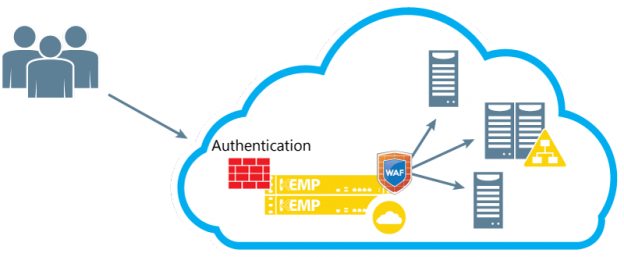Cyber criminals and hackers have been responsible for some of the most remarkable innovations in the domain of website security in terms of protecting web applications against rising trends of cyber attacks. Evolution of Web Application Firewalls can be a unique example of how new technologies are being developed in response to growing technical capabilities of cyber criminals.
Need for an advanced defense mechanism
A brief look at recent cyber attacks is enough to understand that new generation hackers are increasingly targeting web servers, and web applications apart from websites. Frequency as well as intensity of DDoS and SQL injection events is growing alarmingly along with cross site scripting, thereby necessitating immediate security arrangements for a guaranteed defense.
There can be two principal ways to defend servers and applications against new-age cyber attacks that may include improving the resistance to attacks by building applications with special features or implementing advanced firewall security to protect servers and applications from XSS, DDoS and SQL injection attacks among others.
You will agree that the second approach cannot be expected to guarantee security of the entire gamut of applications considering the fact that majority of commonly used applications are not developed with security against SQL injection or XSS events in the first place. Several applications may be victims of session hijacks thereby demanding unique firewall solutions that have advanced defense capabilities such as Web Application Firewall.
Unlike conventional firewalls that are only capable of analyzing only packet headers, Web Application Firewalls have ability to perform analysis of packets’ contents. Interestingly, a WAF can be built to include hardware as well as software although some WAFs are either software or hardware oriented just like their legacy counterparts. Whichever may be the case, Web Application Firewalls apply configured rules of firewall after analyzing requests received via HTTPS and HTTP including GET as well as POST requests.
This unique mode of action helps Web Application Firewalls identify and arrest traffic of malicious visitors that is sure to be ignored by standard security solutions. Since some of the security regulations cover web security of applications, WAFs must be integrated with a SIEM solution. Proactive and proper implementation of WAF can prevent all types of malicious web-traffic from breaking into servers while helping your enterprise adhere to federal security regulations including HIPAA and PCI-DSS among others. This can empower security admins with enhanced monitoring capabilities for ensuring security of the web server.
Some Web Application Firewalls are programmed to demand proof of authenticity to visitors by launching CAPTCHA test to prevent entry of bots into the secure zones of web applications.
Configuration basics of WAFs
There are three important WAF configuration models that individually differ in terms of efficacy for a given context of an application or a web server.
Read More : Considerations for choosing a suitable Web Application Firewall
WAFs can be configured to entertain requests such as HTTP GET, only from specific addresses if Web Application Firewall is configured as per white-listing model. Whenever a user requires the firewall to provide an extremely wide net to prevent a large number of cyber attacks this model can be the best option. However, there is a catch, since a wide net will also prevent authentic traffic from reaching your site. This restricts use of white-listing Web Application Firewalls to a limited infrastructure that may include a handful users or members of staff in an internal environment of an enterprise.
If the application or a business website is operating in a public ecosystem of the internet, that is home to an uncountable variety of cyber crimes and data hacks, then a Web Application Firewall should be configured as a blacklisting model. In such environment there is a huge possibility of an incoming traffic from unidentified sources that could be genuine. In a blacklisting WAF model, there is a provision to arrest obviously malicious traffic by leveraging preset signatures in order to prevent hackers who operate by exploiting vulnerabilities applications as well as websites. When a Web Application Firewall is configured as a blacklisting model, then it will effectively thwart attempts of sending significantly large number of requests from multiple dedicated IP addresses to prevent a possible or an impending DDoS attack.
The third and the most preferred configuration model of Web Application Firewalls is known as hybrid security WAF configuration model. It integrates important properties of blacklisting as well as white-listing configurations to allow a broader security by considering every possible configuration scenario. This type of a WAF configuration is also gaining increasing acceptance in internal networks of enterprises apart from public internet infrastructures.
Takeaway
It is a well-established fat that cyber criminals and hackers focus on websites and applications. The trend of challenging security of websites is here to stay and gain traction as more and more applications and business websites are being launched by startup enterprises. One must develop abilities to secure variety of devices as well as software applications without deviating from the best practices that must be adhered to during the course of web application development.






 Live Chat
Live Chat
